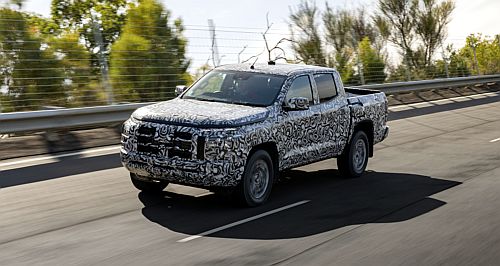News - Mitsubishi - TritonMitsubishi Triton gets Aussie tuning treatmentMitsubishi reveals details of local research and development program for incoming Triton10 Nov 2023 THE sixth-generation Mitsubishi Triton was revealed in Bangkok recently, ahead of its February arrival, but behind the scenes the brand’s local division has been tweaking the ute for harsh Australian conditions.
Mitsubishi Motors Australia Limited (MMAL) has been working alongside the brand’s global research and development team to hone the Triton for local use on a mix of unique road surfaces, leading to a bespoke suspension setup.
The aim, Mitsubishi explains, was to develop a “new-age” ute that offers a ride and handling similar to that of an SUV - a tall order for a utility with a leaf-sprung rear-end.
Leading the Australian validation process was MMAL project manager, Tony Dorrington, a mechanical engineer with a long history of vehicle development Down Under.
“Traditionally utes have been designed with a singular purpose in mind, as a workhorse,” said Mr Dorrington.
“However, in the last five years, customers expect their ute to do the family duties and the weekend activities, as well as working and towing.
“With new-gen Triton we targeted a similar drive experience to a good SUV, with improved agility, responsiveness, and ride comfort, but retaining Triton’s traditional off-road and workhorse capabilities.
“We’ve improved all dynamic elements of the vehicle to ensure new-gen Triton’s performance is a match for Australia’s tough conditions and customer expectations.”
Local development, much of which was undertaken at the former Holden proving ground in Lang Lang, Victoria, led to the testing of more than 100 suspension combinations as the team tweaked dampers, springs and steering calibrations.
“Having access to somewhere like Lang Lang accelerates the process immensely,” said Mr Dorrington.
“We could evaluate changes on multiple road conditions back-to-back to set accurate benchmarks.
“The outcome of our collaboration is a significant reduction in impact harshness, improved body control, enhanced on-centre feel and more linear steering with good feedback.”
Four different front and rear suspension configurations were established at Lang Lang, before senior Mitsubishi executives from Japan evaluated the options landing on a final setup for the Australian models.
Alongside a unique suspension setup, the electronic power steering (EPS) tune is said to improve low-speed manoeuvrability and Mitsubishi even said the Japan-Australia collaboration impacted the global EPS tune.
“As with any new Mitsubishi Motors product, the R&D team first worked with each Triton market to understand their requirements, via a collaborative discussion,” said Mitsubishi Motors Corporation chief vehicle engineer for Triton, Tetsuya Tobe.
“Australia is a very important market for us, particularly in the light commercial segment, so from our initial discussions we created a plan to test the Triton in Australian conditions.
“We also tested extensively in other markets and at Tokachi and Okazaki Japanese R&D centres, but for Australia’s unique road conditions we were able to call on the MMAL team’s local expertise and support to ensure the Triton’s dynamics would compare favourably to the segment benchmarks.”
While pricing is yet to be revealed, MMAL has confirmed the new Triton will be more expensive than the outgoing model, somewhat justified as it catches up to competitor options across key areas like technology, safety, performance and carrying capacity.  Read more |
Click to shareMitsubishi articlesResearch Mitsubishi Triton pricing
Motor industry news |

















Facebook Twitter Instagram